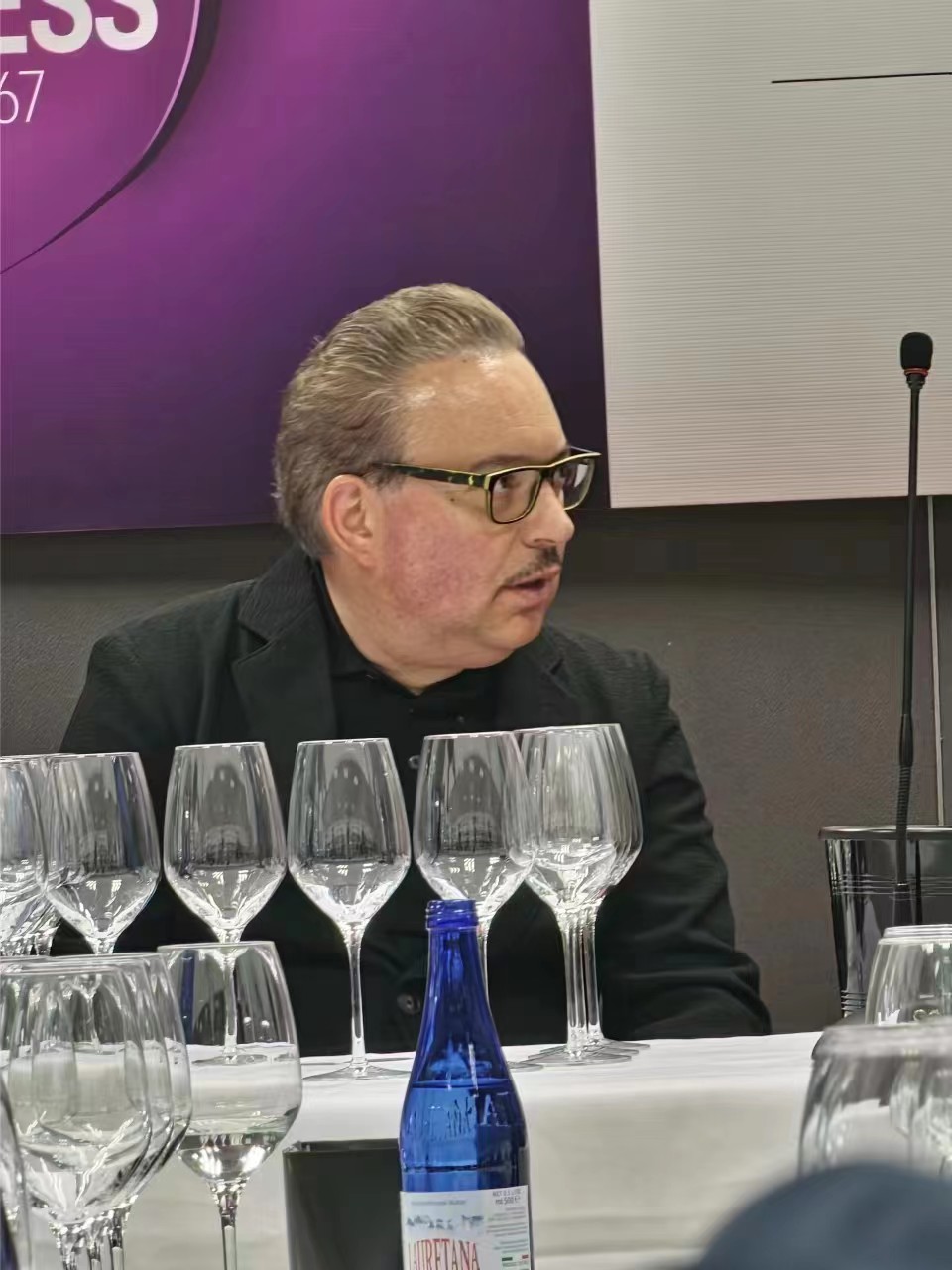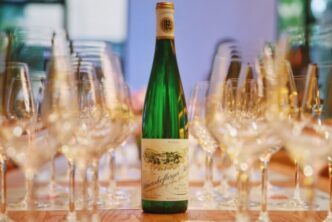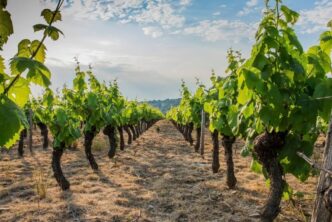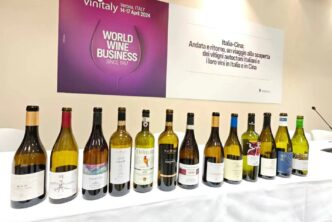I don’t remember now exactly how many masterclasses I have led on Verdicchio’s wines over the decades. Counting the times in which either, or, and both new and old vintage wines of the Verdicchio dei Castelli di Jesi and Verdicchio di Matelica denominations were included, the number must fall well into the thirties range. So you can surmise I know these wines well: and yet, in what is another example of how in life we all never really stop learning, the most recent such masterclass, held on Monday, April 15 at this year’s edition (2024) of Vinitaly, left me literally dumbfounded by the exceptionally high-quality of all the wines presented.
Not that I am not aware that Italy’s Verdicchio wines (both from Matelica and Castelli di Jesi) are not remarkably age-worthy; in fact, for the past fifteen years or so, I have specifically chosen this very topic when guiding Verdicchio-related seminars and tastings all over the world. I believe that age-worthiness is one of the most important hallmarks of Verdicchio’s wines and one that I really believe the wineries should highlight as much as possible. And so, I have had the good fortune to have tasted many old vintages of Verdicchio’s wines over the years, wine tastings that helped not just me but that also had an eye-opening effect on many international sommeliers and wine professionals in attendance who might not have previously had the opportunity to taste so many old vintages of these wines. But even I, after all these years, can and will be surprised by the results of a wine tasting, and this was certainly the case this time around. Simply put, this latest tasting was marked by the presence of the best lineup of Verdicchio wines I have ever had the pleasure and the privilege to taste together all at once. Which is saying something, given how many of these masterclasses I have led over the years. But the wines were just that exceptional, every one currently in their extended sweet spot of tasting.

The Verdicchio grape and the wines: a short overview
For more in-depth information on the Verdicchio grape and its wines, I direct you to one of my award-winning books on the subject, either Native Wine Grapes of Italy (University of California Press, also available at Amazon) or The Grapes and Wines of Italy: The Definitive Compendium Region by Region (Amazon press) or shorter but nonetheless sufficiently detailed pieces I have written here at TerroirSense Wine Review are also good (for example, Verdicchio dei Castelli di Jesi Update: New Vintages, February 4, 2024).
Verdicchio is a native white grape of the Marche, but also grows in Veneto, where a local biotype is known as Trebbiano di Soave (in fact, after the centuries the latter grape has lived in Veneto, it can be considered as a distinct grape variety, given that, after a plethora of genetic mutations that have hit its DNA over the centuries, it doesn’t look much like Verdicchio anymore and its wines taste different too). Good Verdicchio wines offer fresh orchard fruit aromas and flavours, plus fresh citrus fruit and white flower nuances. When the grapes are picked late in the season or the wine has some bottle age on it (about five-six years), the wines also exhibit an almondy note that is very typical of the variety. Such descriptors are common to both the Verdicchio dei Castelli di Jesi and Verdicchio di Matelica wines: the main differences between the two wines is that the latter category is usually marked by higher-acidity and mineral nuances, and less glyceral fruitiness compared to the wines of the Castelli di Jesi, given it is a more inland, mountainous denomination.
Verdicchio dei Castelli di Jesi: what you need to know
Verdicchio dei Castelli di Jesi is the wine and the denomination that dominates the Marche region. The “Castelli di Jesi” monicker is a reference to the many hillside towns that are located near the main town of Jesi, where the future Emperor Federico II of Svevia was born in 1194: all such towns boast at least one castle or noble villa/palace that led to the area being known as one of the “castelli” (castles) that in this case has to be taken to mean more “palace” than “castle”.
The Verdicchio dei Castelli di Jesi is a DOC wine, of which there exist five categories: Verdicchio dei Castelli di Jesi, Verdicchio dei Castelli di Jesi Classico, Verdicchio dei Castelli di Jesi Classico Superiore, Verdicchio dei Castelli di Jesi Passito, and Verdicchio dei Castelli di Jesi Spumante. There also exists one DOCG category wine: Verdicchio dei Castelli di Jesi Riserva Classico, made from select (normally the best) plots of vineyards that give Verdicchio wines that can stand up to the passage of time even better than usual. Differently from the DOC wines, these have to be aged for eighteen months before going on sale (six months of which have to be in bottle).
With few exceptions (Brunello di Montalcino, Barolo), wines in Europe labeled by variety only have to be made with a minimum of 85% of that stated variety (don’t get me started), and so Verdicchio’s wines can be made with at least 85% Verdicchio and up to 15% other white grapes. Verdicchio dei Castelli di Jesi can be produced in 23 communes of the province of Ancona and two of the province of Macerata. Roughly 70% of the vineyards lie between 80-260 meters above sea level, and as the crow flies, no Verdicchio dei Castelli di Jesi vineyard distances from the Adriatic Sea more than 35 kilometers or so. Being an essentially coastal, marine-influenced habitat of gently rolling, low-lying hills, the wines showcase a gentle texture, a glyceral fruitiness, and a mellow acidity that bely their amazing aging potential. About 190,00 hectoliters of this wine are produced a year (for example, this is ten times the volume produced of Verdicchio di Matelica, a much smaller denomination with only a dozen or so producers). Best of all, all Verdicchio dei Castelli di Jesi wines age effortlessly, such that twenty years old Verdicchio wines are a thing of beauty; in fact, they are amongst Italy’s oldest lived white wines.
Last but definitely not least, the next step for the Castelli di Jesi’s Verdicchio producers has to be that of identifying and naming specific subareas within the denomination; subareas that are specifically associated with recognizably different Verdicchio dei Castelli di Jesi wines. Everyone who makes wine in the denomination already knows that, because of a variety of different altitudes, exposures, soil types, ventilation, rainfall, soil water regimens, and sunlight hours, the wines of the towns of Apiro and Cupramontana (for example) are wildly different than those made near Morro d’Alba. So now it’s just a matter of putting pencil to paper or finger to keyboard and getting a zonation or geographic map drawn up. It’s not that hard: I just wrote that the producers of the Mamojà association in Sardinia have done just that with their brilliant geographic-viticultural map highlighting the existence of six different subareas within their territory (TerroirSense Wine Review. Friday May 10, 2024). Given that the Verdicchio dei Castelli di Jesi wine can be made over a not-at-all small 2760+ hectares, I think it should be easy for everyone to understand and realize that speaking as if there exists only one Verdicchio dei Castelli di Jesi wine is nonsense. The production zone boasts a plethora of different altitudes, exposures and many other factors of terroir that can lead, human beings allowing, to the production of highly different wines from subzone to subzone of the denomination.
The wines in this tasting
All the Verdicchio dei Castelli di Jesi wines in this report were tasted by me in Verona during the Masterclass “Castelli di Jesi: La Longevità del Verdicchio” held at Vinitaly 2024 this past April. The wines were tasted in order of vintage, from youngest to oldest.
As mentioned, the tasting was a once-in-a-lifetime affair, given that I have never been involved in any tasting in which all the wines were simply stellar: normally, there is always a couple that lag behind the others in quality level. But not this time. What I fond most interesting was not the quality of the two 2016 wines in the lineup (because we know that one to be an excellent vintage that gave big, showy but at the same time refined wines) but how rather amazingly good the 2017 wines were, a vintage I normally avoid like the plague and not just in the Castelli di Jesi. Hot and droughty, there are very few if any 2017 wines from Italy I enjoy (for example, many Barbera d’Asti wines are outstanding) and I literally never buy them. That much admitted, the 2017 Verdicchio dei Castelli di Jesi wines in this tasting were nothing short of superb: consider me extremely impressed. This finding provides, yet again, another example of how competent the winemaking is in the Jesi area but also how Verdicchio manages to give easy to drink, approachable wines but with real staying power even in poor vintages. And I’m sure you’ll agree, that’s information worth having and something worth knowing.

Sartarelli 2020 Verdicchio dei Castelli di Jesi Classico Superiore Balciana 94+
Vibrant straw-green with a pale golden undertone. Straightforward and energetic at first, then offering rising, sneakily complex aromas of ripe guava, lemon curd, ginger, aromatic herbs, and orange nectar. Similar flavours to the aromas are nicely pliant, deep and pure A note of minerals and minty honey linger nicely on the long suave back end that hints at some slightly air-dried grapes rather than grapes hit by noble rot (which is curious, because the Balciana is a single vineyard where it’s usually noble rot that happens, while the occurrence of grapes air-drying on the vine there is rare). One of Italy’s best white wines, I think Balciana is at its best when a little residual sugar is left in; the 2020 is a very fine example of a not totally bone-dry Balciana, and it’s a really gorgeous, pretty wine with along bright future ahead of it (though I would have left even more r.s. in) and hence the ‘+’ sign on my score. This will very likely earn a higher score in a few years. Drinking window: 2026-2033.
Vallerosa Bonci 2020 Verdicchio dei Castelli di Jesi Classico Superiore San Michele 94+
Limpid straw-green. Nuanced aromas of green apple, lemon verbena, jasmine and crushed rocks. Fresh and zippy in the mouth, but with real density to the old vine fruit and a gorgeous multi-layered mouthfeel make every sip seem like an important one. The aftertaste is long, vibrant and floral. This Verdicchio wine is vinified only in cement. It was first made back in 1989, but the vines had been planted already in the 1970s. Still today, this cru (San Michele cru), located at about 450 meters asl, is considered to be one of the four or five best patches of land in which to grow Verdicchio. Given its high-altitude location and cooler mesoclimate, it is an especially blessed area in hot vintages. The wine is already delicious now, but my guess is it will improve further with a little more bottle age, and hence the ‘+’ sign on my score. Drinking window: 2024-2036.
Vignamato 2018 Verdicchio dei Castelli di Jesi Riserva Classico Ambrosia 94
Medium-dark straw green. At once cool and classic aromas of yellow apple, lime, lemon, and minty herbs. Dense, sappy and low-pitched, with strong floral notes really lifting the the orchard fruit flavours, but also with plenty of juicy balancing acidity really providing lift and length on the finish. Superb: this may well be the best wine I have ever had from Vignamato, which is even more special as it was made in a difficult, not so memorable year. Drinking window: 2024-2030.
Bucci 2017 Verdicchio dei Castelli di Jesi Riserva Classico Villa Bucci 96
Good full vivid straw yellow. Aromas of crystallized lemon peel and white flowers are complicated by almondy nuances and chamomile. Then glycerally sweet, dense and large-scaled, with an impressively tactile quality to its peach, Key lime pie and spice flavours. Despite its richness and its size, this is rather suave and refined, thanks to its harmonious juicy acidity. Marvelous focus and precision here: this is really a drop-dead gorgeous white wine, and made in a hot year, no less. As far as I’m concerned, Ampelio Bucci’s talent knows no bounds. Drinking window: 2024-2032.
La Staffa 2017 Verdicchio dei Castelli di Jesi Classico Riserva Rincrocca 95
Straw-green with some gold. Knockout nose combines ripe yellow apple, pear, citrus peel and flinty minerals. Refined yet powerful, with lively acidity nicely framing the crisp orchard fruit and floral flavours on the tactile, saline palate. Finishes long and pure, with hints of very ripe stone fruits adding further interest and complexity. The Rincrocca vineyard is located high up, at roughly 500 meters asl; its soil is characterized by a high amount of limestone along with the sandstone. If you couple the limestone presence with the knowledge that Rincrocca is surrounded by a forest, you understand immediately why this wine from La Staffa is usually marked by refreshing citrussy acidity and by a truly noteworthy ability to age well. From 2017, a hot vintage, this is just an amazing bottle of white wine. Drinking window: 2024-2032.
Marotti Campi 2017 Verdicchio dei Castelli di Jesi Classico Salmariano 95
Bright straw yellow with some gold. The beautifully chiseled, precise nose offers nuances of jasmine, buttercups, white peach, green apple, minerals, and minty herbs. Then showcases more menthol and mintiness in the mouth, but with powerful orchard fruit flavours that are ripe and suave. The long lemony finish repeats mineral and orchard fruit nuances. Really outstanding Verdicchio wine made in a hot vintage. Wine lovers know that Salmariano is one of Italy’s most ageworthy white wines and that old bottles never disappoint. Drinking window: 2024-2032.
Mirizzi di Montecappone 2017 Verdicchio dei Castelli di Jesi Riserva Ergo sum 94
Golden-tinged straw colour. Tangerine oil, stem ginger, yellow plum and whiffs of dried apricot and diesel fuel on the rather showy, broad nose, lifted by a hint of lavender and saffron. Rich and ripe on the palate, with similar flavours to the aromas, this conveys a distinctly sweeter impression than some other Verdicchio wines I have tasted from the 2017 vintage. Creamy and long, the slow-building finish builds and spreads out impressively on the back end. Made with grapes from a small plot of north-facing vines in the Eroico vineyard of Monte Roberto on marly-yellow sand-clay soils; the wine ages for five years before it is released for sale (one year is spent in a Nomblot cement egg). Drinking window: 2024-2029.
Tenuta dell’Ugolino 2017 Verdicchio dei Castelli di Jesi Classico Superiore Vigneto del Balluccio 94
Vibrant straw hue. Wonderfully nuanced nose offers aromas of white peach, citrus peel, almond flowers and potpourri. Enters broad and minerally at the same time, with plenty of verve to give energy to the ripe pear, apple, peach and nutty flavours. Closes with terrific inner-mouth energy and persistence. The Vigneto del Balluccio, maybe in honour of the fact it was named after someone who loved to dance, is remarkably adept at turning out wines that are light on their feet and graceful. All kidding aside, there is a lightness of being here that isn’t always common in Verdicchio wines and especially so when made with grapes grown on strongly clay soils as are those of this part of Castelplanio, where the Vigneto del Balluccio is located. These vines average 25 years of age and face south/southwest. Drinking window: 2024-2031.
Pievalta 2016 Verdicchio dei Castelli di Jesi Riserva Classico San Paolo 95
Medium-deep straw-yellow with some gold. Deep, racy aromas of apple, pear, orange peel, and green cardamom are lifted by menthol and spices. Big, broad and tactile in the mouth, but with lovely lift to the flavours of orange peel, balsamic oils and spices. Offers volume and texture but also a nice light touch, leaving an impression of being. Despite how big it is, still tightly coiled and with plenty more to offer. Finishes long and suave, with a late hint of stem ginger and apple. Drinking beautifully, this is maybe the best wine I have ever had from Pievalta. Drinking window: 2024-2028.
Tenuta di Tavignano 2016 Verdicchio dei Castelli di Jesi Riserva Classico Misco 95
Medium yellow-green with some gold. Complex nose combines apple, lemon zest, apricot, licorice and balsamic oils, all lifted by a floral top-note. Big, rich and spicy but with excellent lift to the finely-grained texture and a slowly building finish that lingers nicely with notes of minty herbs, lemon curd and orange zest. Very smooth, large-scaled and deep Misco Riserva from what is an undoubtedly excellent vintage that gave big but refined Verdicchio wines. This easily one of the best wines I have ever had from Tenuta di Tavignano. Drinking window: 2024-2029.

 English
English




Excellent article!! Bravo ….Love Verdicchio!
Attention: The correct wording is: Castelli di Jesi Verdicchio Riserva , but Verdicchio di Matelica Riserva
Ciao, thanks you are right! It was a Freudian slip on my part, because I believe in always putting the grape variety first and foremost. You know, most wine loving people out there in our big big world haven’t got a clue where Jesi is, or what “castelli” means, but they might have heard of Verdicchio, and I really believe this helps people remember and get to know wines better. Besides, I can tell you for a fact that a number of the losal producers are unhappy with the “demotion” of the word Verdicchio in order of place in the name. But I have to admit, you caught me with my pants down on this one! Thanks!
Ciao, thanks you are right! It was a Freudian slip on my part, because I believe in always putting the grape variety first and foremost. You know, most wine loving people out there in our big big world haven’t got a clue where Jesi is, or what “castelli” means, but they might have heard of Verdicchio, and I really believe this helps people remember and get to know wines better. Besides, I can tell you for a fact that a number of the local producers are unhappy with the “demotion” of the word Verdicchio in order of place in the wine’s name. But I have to admit, precision requires that at elast I mention that the exact name of the wine is Castelli di Jesi Verdicchio Riserva! Thanks!
Ciao there,
thanks for the nice words and in pointing out something that is absolutely true, and has been so since 2011. So you are quite correct!
But just so you and everybody else out there understands where it is that I am coming from, mine is more than just a Freudian slip: it’s a specific desire to highlight the name of the grape variety used to make these wines.
Everyone in Italy is trying to highlight the name of the area their wines come from, or in other words establish a specific terroir identity, much as is done with the terms Margaux and Chambolle-Musigny, for example, which in an of itself neither short-sighted nor wrong. But what they forget in Italy (and some do so very conveniently and for vested interests), or fail to grasp, is that terroirs in France have long been associated with grape varieties everybody knows. Burgundy and Bordeaux are terroir wines that it is easier to understand and recognize as such, and you can have everybody focus on those realities, because everybody understands what the Cabernets, Merlot, Pinot Noir and Chardonnay wines are about or what they should taste of/like. Not so with the majority of Italy’s wines: besides the fact that very few wine lovers out there have any idea where the Castelli di Jesi are exactly (or the Marche for that matter), they know little about Verdicchio so unless we get that specific message across, they will never be able to understand the wines, given that the altitude, soil type, water regimen and macroclimate of the area won’t help anybody understand or know much the wines on their own. In fact, I can tell you that more than one vignaiolo/producer of these wines is not happy with the demotion of the world “Verdicchio” in the pecking order of the wine’s name. Some would even want to go as far as removing the word “Verdicchio” altogether, which is sheer folly, and many winery owners have flat out told me they will never accept that.
But forgetting about all of this for a moment, you are right that the wine’s name is Castelli di Jesi Verdicchio Riserva, so thanks for making that ultra-clear!
Ian